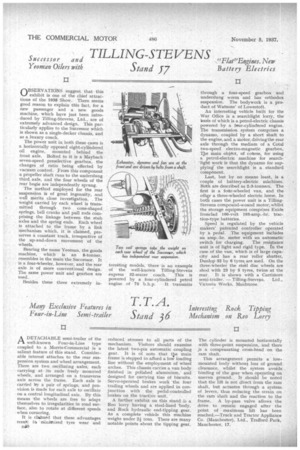TILLING-STEVENS
Page 64

If you've noticed an error in this article please click here to report it so we can fix it.
Stand 17 QBSEVVATIONS suggest, that this exhibit is one of the Chief attractions of the 1936 Show. There seems good reason to explain this fact, for a new passenger and a new goods machine, which have just been introduced by Tilling-Stevens, Ltd., are of extremely advanced design. This particularly applies to the Sticcessor which is shown as a single-decker chassis, and as a luxury coach.
The power unit in both these cases is a horizontally opposed eight-cylindered. oil engine, mounted behind the front axle. Bolted to it is a Maybach seven-speed preselective gearbox, the changes of ratio being effected by vacuum control. From this component a propeller shaft runs to the underslung third, axle, and the four wheels of the rear bogie are independently sprung. The method employed for the rear suspension is of great ingenuity, and well merits close investigation. The weight carried by each wheel is transmitted through two cone-shaped springs, bell cranks and pull rods comprising the linkage between the stub axles and the spring ends. Each wheel is attached to the frame by a link mechanism which, it is claimed, preserves a constant track, irrespective of the up-and-down movement of 'the wheels.
Bearing the name Yeoman, the goods machine, which is• an 8-tonner, resembles in the main the Successor. It is a four-Wheeler, however, and the rear axle is of more conventional design. The same power unit and gearbox are used.
Besides these three extremely in tereSting models, there is an example of the well-knoWn Tilling-Stevens • express 32-seater coach. This is powered by a four-cylindered petrol engine of 75 b.h.p. It transmits through a four-speed gearbox and underslung worm and has orthodox suspension. The bodywork is a product of Watsons' of Lowestoft.
An interesting vehicle built for the War Office is a searchlight lorry, the basis of which is a petrol-electric chassis powered by a four-cylindered engine. The transmission system comprises a dynamo, coupled by a short shaft to the engine, and a motor, driving the rear axle through the medium of a Cotal two-speed electro-magnetic gearbox. The main object, of coarse, for using a petrol-electric machine for search' light work is that the dynamo for supplyingthe searchlight is a standard component. Last, but by no means least, is a couple of battery-electric nffichines. BOth are described as 2-3-tonners. The first is a four-wheeled van, and the otlagr a three-wheeled electric horse. In both cases the power unit is a TillingStevens compound-wound motor, whilst the storage equipment comprises Exide Ironclad 100-volt 193-amp.-hr. traction-type batteries.
Speed is regulated by the vehicle makers' patented controller operated by a pedal. The equipment includes an amp.-hr meter with an automatic
switch for charging. The resistance unit is of light and rigid type. fn the case of the van, which is of large capacity and has a rear roller shutter, Dunlop 32 by 6 tyres are used. On the three-wheeler the steel disc wheels are shod with 23 by 5 tyres, twins at the rear. It is shown with a Carrimore
semi-trailer. — Tilling-Stevens, Ltd., Victoria Works, Maidstone


















































































